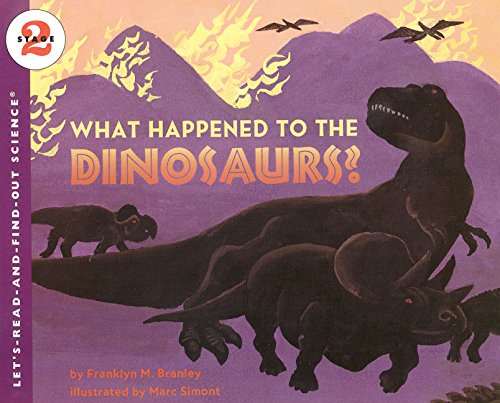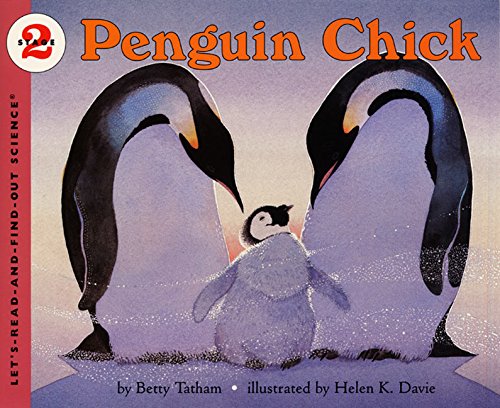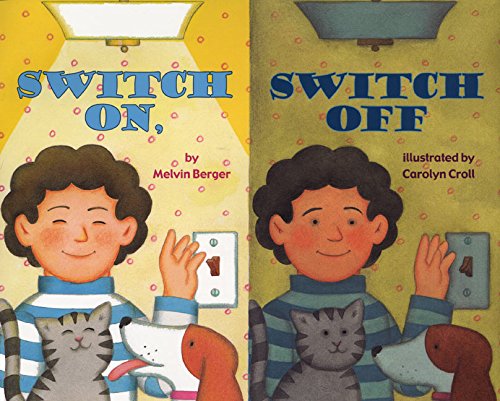-
What Happened to the Dinosaurs?
BRANLEY, Dr. Franklyn M. Branley, Marc Simont
Paperback (HarperCollins, June 21, 2000)In this enlarged edition of the Level 2 Let's-Read-and-Find-Out Science book, distinguished writer Franklyn M. Branley and award-winning artist Marc Simont provide the perfect introduction to an always fascinating subject—the disappearance of the dinosaurs. This nonfiction picture book is an excellent choice to share during homeschooling, in particular for children ages 4 to 6. It’s a fun way to learn to read and as a supplement for activity books for children.What happened to the dinosaurs?For millions of years these fantastic creatures roamed our planet. Then, suddenly, they all disappeared. Scientists wonder why. What could have caused this huge extinction 65 million years ago?This is a Level 2 Let’s-Read-and-Find-Out Science title, which means the book explores more challenging concepts for children in the primary grades and supports the Common Core Learning Standards, Next Generation Science Standards, and the Science, Technology, Engineering, and Math (STEM) standards. Let’s-Read-and-Find-Out is the winner of the American Association for the Advancement of Science/Subaru Science Books & Films Prize for Outstanding Science Series.Outstanding Science Trade Books for Children 1989 (NSTA/CBC) L
L
-
Almost Gone: The World's Rarest Animals
Steve Jenkins
Paperback (HarperCollins, Jan. 31, 2006)Have you seen a northern hairy-nosed wombat or an eastern barred bandicoot? These animals are so rare, they might disappear forever, and they're not alone. Read and find out about some of the animals that are almost gone. This nonfiction picture book is an excellent choice to share during homeschooling, in particular for children ages 5 to 7. It’s a fun way to learn to read and as a supplement for activity books for children.This is a Level 2 Let’s-Read-and-Find-Out Science title, which means the book explores more challenging concepts for children in the primary grades and supports the Common Core Learning Standards, Next Generation Science Standards, and the Science, Technology, Engineering, and Math (STEM) standards. Let’s-Read-and-Find-Out is the winner of the American Association for the Advancement of Science/Subaru Science Books & Films Prize for Outstanding Science Series. R
R
-
Gravity Is a Mystery
Dr. Franklyn M. Branley, Edward Miller
Paperback (HarperCollins, May 29, 2007)What goes up must come down. Everybody knows that. But what is it that pulls everything from rocks to rockets toward the center of the earth? It’s gravity. Nobody can say exactly what it is, but gravity is there, pulling on everything, all the time. With the help of an adventurous scientist and his fun-loving dog, you can read and find out about this mysterious force. This nonfiction picture book is an excellent choice to share during homeschooling, in particular for children ages 5 to 7. It’s a fun way to learn to read and as a supplement for activity books for children.This is a Level 2 Let’s-Read-and-Find-Out Science title, which means the book explores more challenging concepts for children in the primary grades and supports the Common Core Learning Standards, Next Generation Science Standards, and the Science, Technology, Engineering, and Math (STEM) standards. Let’s-Read-and-Find-Out is the winner of the American Association for the Advancement of Science/Subaru Science Books & Films Prize for Outstanding Science Series. M
M
-
Penguin Chick
Betty Tatham, Helen K. Davie
Paperback (HarperCollins, Dec. 18, 2001)An emperor penguin lays an egg on the Antarctic ice. In the bitter cold, miles away from the only source of food, how can the chick survive? A father penguin keeps his mate's egg warm by balancing it on his feet for two entire months. Learn how penguin parents take care of their babies in one of Earth's coldest, most desolate environments. This nonfiction picture book is an excellent choice to share during homeschooling, in particular for children ages 5 to 7. It’s a fun way to learn to read and as a supplement for activity books for children.This is a Level 2 Let’s-Read-and-Find-Out Science title, which means the book explores more challenging concepts for children in the primary grades and supports the Common Core Learning Standards, Next Generation Science Standards, and the Science, Technology, Engineering, and Math (STEM) standards. Let’s-Read-and-Find-Out is the winner of the American Association for the Advancement of Science/Subaru Science Books & Films Prize for Outstanding Science Series. O
O
-
Starfish
Edith Thacher Hurd, Robin Brickman
Paperback (HarperCollins, May 3, 2000)Starfish have arms, but no legs. They have feet, but no toes. Starfish aren't fish, but they are living animals. Kids learn how starfish move, eat, and grow in Edith Hurd's poetic text, illustrated with Robin Brickman's vivid watercolor collages. This nonfiction picture book is an excellent choice to share during homeschooling, in particular for children ages 4 to 6. It’s a fun way to learn to read and as a supplement for activity books for children.This is a Stage 1 Let's-Read-and-Find-Out, which means the book explains simple science concepts for preschoolers and kindergarteners. Let's-Read-And-Find-Out is the winner of the American Association for the Advancement of Science/Subaru Science Books & Films Prize for Outstanding Science Series. Supports the Common Core Learning Standards and Next Generation Science Standards M
M
-
Dinosaurs Big and Small
Kathleen Weidner Zoehfeld, Lucia Washburn
Paperback (HarperCollins, May 7, 2002)Some dinosaurs were big. How big? As long as four school buses in a row, as heavy as sixteen elephants. Some dinosaurs were small. How small? Read and find out! This nonfiction picture book is an excellent choice to share during homeschooling, in particular for children ages 4 to 6. It’s a fun way to learn to read and as a supplement for activity books for children.This is a Level One Let’s-Read-and-Find-Out Science title, which means the book explores more challenging concepts for children in the primary grades and supports the Common Core Learning Standards, Next Generation Science Standards, and the Science, Technology, Engineering, and Math (STEM) standards. Let’s-Read-and-Find-Out is the winner of the American Association for the Advancement of Science/Subaru Science Books & Films Prize for Outstanding Science Series. J
J
-
Floating in Space
Dr. Franklyn M. Branley, True Kelley
Paperback (HarperCollins, Jan. 3, 1998)Don't jump! If you're on the space shuttle, that is. Astronauts never jump in space. They usually drink out of straws, and they lift tons of equipment as if it were light as air. Find out more in this information-packed voyage into space. This nonfiction picture book is an excellent choice to share during homeschooling, in particular for children ages 4 to 6. It’s a fun way to learn to read and as a supplement for activity books for children.This is a Level 2 Let’s-Read-and-Find-Out Science title, which means the book explores more challenging concepts for children in the primary grades and supports the Common Core Learning Standards, Next Generation Science Standards, and the Science, Technology, Engineering, and Math (STEM) standards. Let’s-Read-and-Find-Out is the winner of the American Association for the Advancement of Science/Subaru Science Books & Films Prize for Outstanding Science Series. O
O
-
Pinocchio Rex and Other Tyrannosaurs
Melissa Stewart, Steve Brusatte, Julius Csotonyi
Paperback (HarperCollins, Nov. 7, 2017)Everyone knows that Tyrannosaurus rex is the huge dinosaur with sharp claws and tiny arms. But in this appealing level 2 picture book from acclaimed science writer Melissa Stewart, you’ll learn that T. rex is not the only tyrannosaur that existed in prehistoric times. This nonfiction picture book is an excellent choice to share during homeschooling, in particular for children ages 4 to 6. It’s a fun way to learn to read and as a supplement for activity books for children.In the last fifteen years, scientists have found many tyrannosaurs, including one with a really long pointy nose. The New York Times bestselling coauthor of this book, Dr. Steve Brusatte, went to China in order to help ID the dinosaur that he would give the nickname Pinocchio Rex!This book is the perfect overview of the exciting new discoveries in the land of tyrannosaurs. Read and find out how tyrannosaurs evolved—from the tiny Dilong to the enormous T. rex. The book also includes an infographic, activity, and glossary, as well as “Dr. Steve Says” sidebars that give readers insight into what it felt like for Dr. Steve to be involved with the discovery of P. Rex! This is a Level 2 Let’s-Read-and-Find-Out Science title, which means the book explores more challenging concepts for children in the primary grades and supports the Common Core Learning Standards, Next Generation Science Standards, and the Science, Technology, Engineering, and Math (STEM) standards. Let’s-Read-and-Find-Out is the winner of the American Association for the Advancement of Science/Subaru Science Books & Films Prize for Outstanding Science Series. M
M
-
Thump Goes the Rabbit: How Animals Communicate
Fran Hodgkins, Taia Morley
Paperback (HarperCollins, Jan. 7, 2020)Did you know that animals each have their own unique way to communicate? Birds sing, dogs bark, cows moo—and animals use their ears, tails, feet, and bodies to communicate, too! But what is everybody saying? This nonfiction picture book is an excellent choice to share during homeschooling, in particular for children ages 4 to 6. It’s a fun way to learn to read and as a supplement for activity books for children.Let’s read and find out about how animals communicate and what they’re talking about!Thump Goes the Rabbit is filled with bright, accurate art and includes ton of visual aids like sidebars, an infographic, and a hands-on activity all about how to be a citizen scientist and make good observations in your own environment.This is a Level 1 Let’s-Read-and-Find-Out, which means the book explores introductory concepts perfect for children in the primary grades and supports the Common Core Learning Standards, Next Generation Science Standards, and the Science, Technology, Engineering, and Math (STEM) standards. Let’s-Read-and-Find-Out Science is the winner of the American Association for the Advancement of Science/Subaru Science Books & Films Prize for Outstanding Science Series. E
E
-
Switch On, Switch Off
Melvin Berger, Carolyn Croll
Paperback (HarperCollins, Sept. 4, 2001)It seems like magic! It's not—it's electricity. But how does a light actually work? In this clear and simple book learn all about electricity, how it's produced, and how it can be used. At the end you'll learn how to conduct fun experiments that will let you generate electricity yourself! This nonfiction picture book is an excellent choice to share during homeschooling, in particular for children ages 4 to 6. It’s a fun way to learn to read and as a supplement for activity books for children.This is a Level 2 Let’s-Read-and-Find-Out Science title, which means the book explores more challenging concepts for children in the primary grades and supports the Common Core Learning Standards, Next Generation Science Standards, and the Science, Technology, Engineering, and Math (STEM) standards. Let’s-Read-and-Find-Out is the winner of the American Association for the Advancement of Science/Subaru Science Books & Films Prize for Outstanding Science Series. L
L
-
I'm Growing!
Aliki
Paperback (HarperCollins, Sept. 4, 2001)The food we eat helps our bones and muscles, skin and hair, teeth and toenails grow bigger and longer and stronger. Inside and outside, we grow and grow without even knowing it! With her trademark simple words and delightful pictures, acclaimed children's writer Aliki helps young readers understand how their bodies change and grow. This nonfiction picture book is an excellent choice to share during homeschooling, in particular for children ages 4 to 6. It’s a fun way to learn to read and as a supplement for activity books for children.I'm Growing! is a Level One Let’s-Read-and-Find-Out Science title, which means the book explores more challenging concepts for children in the primary grades and supports the Common Core Learning Standards, Next Generation Science Standards, and the Science, Technology, Engineering, and Math (STEM) standards. Let’s-Read-and-Find-Out is the winner of the American Association for the Advancement of Science/Subaru Science Books & Films Prize for Outstanding Science Series. I
I
-
Dinosaur Bones
Aliki
Paperback (HarperCollins, March 10, 1990)How do we know what dinosaurs were like? This nonfiction picture book is an excellent choice to share during homeschooling, in particular for children ages 4 to 6. It’s a fun way to learn to read and as a supplement for activity books for children.Dinosaurs roamed the earth millions of years ago. Then suddenly they all died out. How do we know now what they looked like? How do we know that they really existed at all? Read and find out how scientists have proven the existence of dinosaurs by studying fossil remains. Each new fossil find helps them to ice together a picture of what the world was like millions of years ago.As Children's Books and Their Creators put it: Aliki "treats complex topics clearly and succinctly while providing lively pictures, with informative details and humorous elements often appearing in 'balloons.'" Aliki's books continue to speak to today's young readers.This is a Level 2 Let’s-Read-and-Find-Out Science title, which means the book explores more challenging concepts for children in the primary grades and supports the Common Core Learning Standards, Next Generation Science Standards, and the Science, Technology, Engineering, and Math (STEM) standards. Let’s-Read-and-Find-Out is the winner of the American Association for the Advancement of Science/Subaru Science Books & Films Prize for Outstanding Science Series. P
P